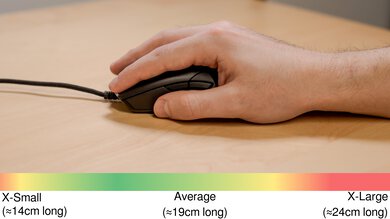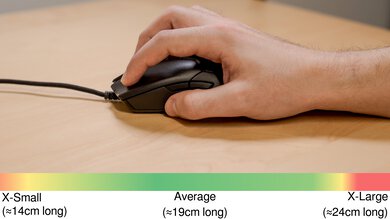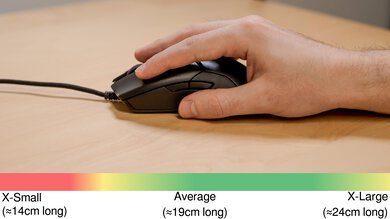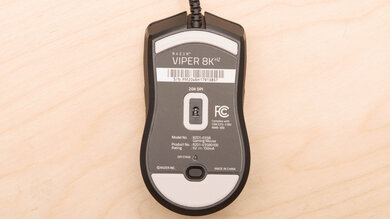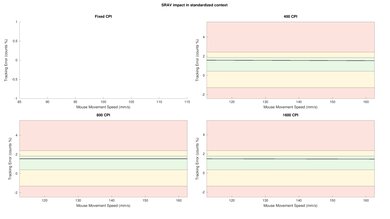The Razer Viper 8KHz is a lightweight, true ambidextrous mouse thanks to the two buttons on either side. It looks physically identical to the Razer Viper, but with a slightly thicker cable and smoother-gliding feet. It has an incredibly low click latency, a low lift-off distance, and a wide CPI range. Like the Razer Viper, it's suitable for most hand sizes when using a fingertip grip, but people with small hands may struggle to reach the L/R clicks and scroll wheel. What sets it apart from other gaming mice is its 8000Hz maximum polling rate, which produces smoother cursor movements and marginally lower click latency.
Our Verdict
The Razer Viper 8KHz is mediocre for office use. While it doesn't have an ergonomic shape like some dedicated office mice, it should still feel very comfortable for most hand sizes using a claw or fingertip grip and for small and medium hands using a palm grip. It feels very well-built and has many programmable buttons; unfortunately, its customization software isn't available on macOS. Also, it isn't wireless, and some people might find the cable cumbersome.
-
Feels very well-built.
-
Comfortable, ambidextrous design.
-
Four programmable side buttons.
-
Wired-only design may be cumbersome.
-
Software isn't compatible on macOS.
-
Cable isn't as flexible as some other options.
The Razer Viper 8KHz is excellent for FPS gaming. It's surprisingly very light for a mouse without a honeycomb design and feels very well-built. Its ambidextrous body has a low profile that's great for a fingertip grip, but small hands may struggle to reach some buttons. It has a wide and adjustable CPI range, an incredibly low click latency, and a low lift-off distance. Its 8000Hz maximum polling rate provides smoother and more consistent cursor movements than a gaming mouse with a standard 1000Hz polling rate.
-
8000Hz polling rate.
-
Incredibly low click latency.
-
Feels very well-built.
-
Very light.
-
Comfortable, ambidextrous design.
-
Software isn't compatible on macOS.
-
Cable isn't as flexible as some other options.
The Razer Viper 8KHz is very good for MMO gaming. While it doesn't have nearly as many side buttons as dedicated MMO mice, it does have two side buttons on either side, which is more than many other gaming mice. On the bright side, it has superb click latency, a wide and customizable CPI range, and a low lift-off distance. Also, it has an 8000Hz maximum polling rate, so cursor movements feel smoother and more consistent. It feels very well-built and very comfortable, but people with larger hands may struggle with a palm grip.
-
8000Hz polling rate.
-
Incredibly low click latency.
-
Feels very well-built.
-
Comfortable, ambidextrous design.
-
Software isn't compatible on macOS.
-
Cable isn't as flexible as some other options.
-
Not nearly as many side buttons as dedicated MMO mice.
-
Feels very well-built.
-
Cable isn't as flexible as some other options.
- 6.1 Work
- 9.2 Video Games (FPS)
- 8.4 Video Games (MMO)
- 9.7 Raw Performance
Changelog
- Updated May 07, 2024: We've added a link to the newly-reviewed Endgame Gear OP1 8k in the Hand Size Recommendation section of this review.
- Updated Jan 05, 2024: We've updated the CPI graph displayed in the Sensor Latency section of this review. Our results remain the same, but these graphs have two new columns with results from the Delay At Half Movement and Delay To End Of Movement tests.
- Updated Oct 02, 2023: We've added text to this review for the new tests added in TBU 1.5.
- Updated Oct 02, 2023: We've converted this review to Test Bench 1.5. This update adds a new Main Button test group, which provides button actuation data and switch information. We've also made minor changes to how we calculate the Office usage score. For more details, you can see our full changelog here.
- Updated Jul 06, 2023: We've added a link to the newly-reviewed Razer Viper Mini Signature Edition in the Sensor Specifications section of this review.
Check Price
Differences Between Sizes And Variants
The Razer Viper 8KHz has no variants, and it's only available in black. See the label of our unit here.
Compared To Other Mice
While it has the same ambidextrous design as other mice in the Viper lineup, with buttons on both sides, the biggest difference with the Razer Viper 8KHz is its maximum polling rate of 8000Hz. It should provide even smoother cursor movements and less micro stutter than mice with 1000Hz polling rates. Apart from this, it has incredibly low click latency, a very wide and adjustable CPI range, and an extremely consistent sensor.
For other options, see our recommendations for the best gaming mice and the best wired mice, and if you'd prefer a wireless design, check out the best wireless gaming mice.
The Razer DeathAdder V3 and the Razer Viper 8KHz are wired gaming mice with extremely similar high-end gaming performance. The DeathAdder V3 is significantly lighter and has a right-handed shape. On the other hand, the Viper 8Khz has a symmetrical shape. Both mice support a maximum polling rate of 8000Hz.
The Razer Cobra and the Razer Viper 8KHz have the same symmetrical shape, but the Cobra is smaller. The Cobra is lighter and has RGB lighting, which the Viper lacks. On the other hand, the Viper 8KHz has a slightly more lightweight and flexible cable, better sensor accuracy, and it supports a higher maximum polling rate of 8000Hz.
The Razer Viper 8KHz and the Endgame Gear OP1 8k are wired gaming mice with symmetrical shapes and 8000Hz maximum polling rates. Both mice offer exceptional raw gaming performance. On the one hand, the Endgame Gear uses SPDT mechanical switches and has lower click latency. It's also significantly more lightweight, making it easier to move more quickly and accurately. It's also noticeably smaller, so it isn't as accommodating for larger-sized hands. On the other hand, the Razer has a fully ambidextrous design with a pair of side buttons on either side. It also uses optical switches and has slightly better overall sensor performance.
The Razer Viper V2 Pro and the Razer Viper 8KHz are very similar mice from the same lineup. They share the same shape, but the V2 Pro connects wirelessly, while the 8KHz is a wired-only mouse. The V2 Pro is also lighter and feels a bit sturdier. That said, while the V2 Pro supports a standard maximum polling rate of 1000hz, the 8KHz supports a maximum polling rate of up to 8000Hz.
The Razer Viper 8KHz and the Logitech G PRO X SUPERLIGHT are both excellent FPS gaming mice. If you're a fan of ultra-light mice, the Logitech is worth considering because it's one of the lightest wireless mice we've ever tested. Also, it can be used both wired and wireless, and it's fully compatible with macOS. On the other hand, the Razer has RGB lighting, two programmable side buttons on each side, and marginally lower click latency. Also, it has an 8000Hz polling rate.
The Razer Viper 8KHz performs better than the Razer Viper Mini for most uses, though both mice look similar. The 8KHz is slightly bigger and feels a little more comfortable, especially if you have medium or large hands. Performance-wise, it has a much wider CPI range that you can adjust more precisely and with very little variation. It also has a lower lift-off distance and an outstanding maximum polling rate of 8000Hz, which results in smoother movement, though we don't test for this. Lastly, the 8KHz features two side buttons on each side, while the Mini only has two buttons on its left side. That said, the Mini is smaller and weighs a bit less, so it may be a better choice for people with smaller hands, especially those using a fingertip grip.
The HyperX Pulsefire Haste 2 and the Razer Viper 8KHz are wired gaming mice with maximum polling rates of 8000Hz. The HyperX is significantly lighter and has a single RGB lighting zone in the scroll wheel. On the other hand, the Razer has lower click latency and no RGB lighting.
The Razer Viper 8KHz and the Razer Viper Ultimate have the same ambidextrous body, but the Viper Ultimate is wireless, while the 8KHz is wired-only. Aside from some slight variances, like the 8KHz's slightly lower click latency and more consistent sensor, the biggest difference is the max polling rate. While the Ultimate caps out at 1000Hz, the 8KHz can be set as high as 8000Hz, which results in more fluid cursor movements, though we don't currently test this.
The Razer Viper 8KHz and the Razer Viper Mini Signature Edition are gaming mice in the same product lineup that support 8000Hz polling rates. The Viper 8KHz is a larger, wired-only model. On the other hand, the Viper Mini Signature Edition is a wireless model that's significantly lighter and has a magnesium alloy exoskeleton body.
The Razer Viper 8KHz and the Logitech G502 HERO are both wired gaming mice, but the Razer performs better overall. It feels better built and has an ambidextrous design, and it's significantly lighter. It also has lower click latency and a higher maximum polling rate. On the other hand, the Logitech has a scroll wheel with L/R tilt inputs and a free-scrolling mode. It also has a sniper button and a thumb rest.
The Razer Viper 8KHz and the Razer Basilisk V3 are both excellent wired gaming mice. The Viper 8Hkz is significantly lighter and has a higher maximum polling rate. It also has two side buttons on the left and right side, while the [nolink:Basilisk V3} only has side buttons on the left. On the other hand, the [nolink:Basilisk V3] has a thumb rest and three additional buttons overall. Its mouse wheel also has L/R functions and a free-scrolling mode that you can set to enable automatically.
The Razer Viper 8KHz and the Razer DeathAdder V2 are excellent wired FPS gaming mice that perform similarly. The 8KHz is an ambidextrous mouse with two buttons on each side, and it has an 8000Hz polling rate, which should provide more fluid cursor movements; however, we currently don't test this. On the other hand, the DeathAdder V2 has a higher back with a slanted, right-handed design, so it's more suitable for a palm grip no matter your hand size.
The Razer Viper 8KHz is a better gaming mouse than the Logitech G Pro Wireless, but the Logitech is more versatile. The Logitech can be used wired or wirelessly, and it's fully compatible with both Windows and macOS. It's slightly heavier than the Razer, but it's still lightweight, and you can easily bring it with you on the go. It has a nearly universal shape that should fit most hand sizes and grip types. On the other hand, the Razer is a bit lighter, and its shape is better suited for a claw grip or a fingertip grip if you have medium to extra-large hands. It has a much better cable and feet that glide more smoothly. While its CPI range isn't as wide as the Logitech, its maximum polling rate is impressively high at 8000Hz. This should results in smoother movements, though we don't test for this at the moment.
The Razer Viper and the Razer Viper 8KHz have the same shape and design, but the 8KHz has smoother-gliding feet and a thicker cable. It also has a lower click latency and has onboard memory. The biggest difference between the two is the 8000Hz polling rate on the 8KHz, which means its cursor movements should feel more fluid, though we don't currently test this. If you want a future-proof mouse with onboard memory, the 8KHz is an excellent choice.
The Razer Viper 8KHz and the Corsair SABRE PRO are wired mice with similar performance, including maximum polling rates of 8000Hz. The Corsair has a right-handed shape that's well-suited for palm grip, regardless of hand size, but those with small and medium-sized hands may not be able to reach all buttons using a claw or fingertip grip. It has a narrower CPI range, but you can set the CPI by increments of one using the companion software compatible with Windows and macOS. On the other hand, the Razer has an ambidextrous shape that's well-suited for smaller hands using a palm or claw grip and larger hands using a fingertip grip. Its CPI has a wider range but can only be set by increments of 50. It also has two additional side buttons on the right side, RGB lighting, and better mouse feet, although its software is only compatible with Windows.
The GLORIOUS Model O 2 and the Razer Viper 8KHz are wired gaming mice. The GLORIOUS is significantly lighter and has RGB lighting, but it also has small circular cutouts in its body to reduce its overall weight. On the other hand, the Razer has a solid plastic shell. It also has slightly better click latency and overall sensor performance and natively supports a maximum polling rate of 8000Hz.
The Razer Viper 8KHz and the Razer Basilisk V2 are both excellent FPS gaming mice. The V2 has a thumb rest and a sniper button on its left side, and overall has more programmable inputs, but its click latency is slightly higher. On the other hand, you can set the 8KHz to a maximum of 8000Hz, which provides more fluid cursor movements, though we don't currently test this. The 8KHz also has two buttons on both of its sides.
The Logitech M100 is a sub-par, budget office mouse, while the Razer Viper 8KHz is an excellent FPS gaming mouse. The Razer feels sturdier, has four side buttons, a more flexible cable, and better-gliding mouse feet. It also has an adjustable CPI, a much higher polling rate of 8000Hz, a significantly lower click latency, and software for customization. The Razer is best-suited for a palm or claw grip for smaller hands or a fingertip grip for larger hands. Comparatively, the Logitech is lighter and well-suited for all grip types and nearly all hand sizes.
The Razer Viper 8KHz is a better wired gaming mouse than the Redragon M602 Griffin RGB Wired. The Razer is much more lightweight and feels sturdier. It has a more flexible cable, mouse feet that glide more smoothly, and two additional side buttons on the right side, making it a great choice for right or left-handed users. Performance-wise, it has a much wider CPI range, a CPI you can adjust precisely and consistently, and a significantly lower lift-off distance. It also has a much higher maximum polling rate of 8000Hz, and a much lower click latency. On the other hand, the Redragon has a thumb and pinky rest.
The Razer Viper 8KHz is a better wired gaming mouse than the Redragon M601 RGB Centrophorus. The Razer is lighter, it has a cable that's more flexible, and it has mouse feet that glide more smoothly. It also has a much wider CPI range, a CPI you can adjust precisely by increments of 50, a much lower click latency, a lower lift-off distance, and a higher maximum polling rate of 8000Hz. It also has two additional side buttons on the right side, and you can set a HyperShift button to enable a secondary layer of controls. On the other hand, the Redragon has a set of added weights for adjusting the weight distribution, which the Razer lacks.
The Razer Viper 8KHz performs better overall than the Nixeus REVEL Fit. The Razer has a lighter weight, a better build quality, a more flexible cable, and much smoother–gliding feet. Performance-wise, it has a wider CPI range, a more precisely adjustable CPI, a much lower lift-off distance, and significantly lower click latency. It has a maximum polling rate of 8000Hz that should make the cursor movements feel smoother and more fluid than the Nixeus' 1000Hz polling rate, but we don't currently test this.
The Razer Viper 8KHz and the Razer Pro Click Mini are designed for different uses. The Viper 8KHz is better suited for gaming, while the Pro Click Mini is better suited for office use. The Viper 8KHz has lower click latency, a higher maximum polling rate, and it feels more comfortable to use. On the other hand, the Pro Click Mini is wireless-only, has Bluetooth compatibility, and has a scroll wheel that unlocks for infinite scrolling.
The Razer Viper 8KHz and the Keychron M1 are comparable wired gaming mice, but the Razer is a better choice for gaming overall. The Razer feels sturdier and has higher-quality mouse feet that glide more smoothly. It also has a significantly lower click latency, a higher maximum CPI, a CPI you can adjust more precisely, and a higher maximum polling rate of 8000Hz. On the other hand, the Keychron has a higher quality, detachable paracord-like cable, and its software is compatible with Windows and macOS. The Razer software is only compatible with Windows.
The Razer Viper 8KHz and the Logitech Signature M650 are two very different mice. The Razer is a wired-only gaming mouse with a maximum polling rate of 8000Hz. Its click latency is much lower, and it has a much wider CPI range, within which you can precisely adjust the CPI in steps of 50. On the other hand, the Logitech is a wireless office mouse that connects via Bluetooth or its USB receiver. It's very quiet to use, and its software works on both Windows and macOS.
The Razer Viper 8KHz and the Corsair SABRE RGB PRO Wireless are both gaming mice. The Razer is a slightly lighter wired-only model with an ambidextrous design with two side buttons on either side. It supports a maximum polling rate of 8000Hz. On the other hand, the Corsair connects wirelessly and has a right-handed shape.
The Razer Viper 8KHz and the GLORIOUS Model D are excellent ultra-light gaming mice, but the Razer performs better overall. The Razer has a truly ambidextrous shape with a pair of side buttons on either side. It also has a wider CPI range, a lower minimum lift-off distance, a somewhat lower click latency, and a higher maximum polling rate of 8000Hz. On the other hand, the GLORIOUS has a right-handed shape. It's also a bit lighter, and its cable is also more flexible.
Test Results
The Razer Viper 8KHz looks identical to the Razer Viper but has a thicker cable. Otherwise, it has the same ambidextrous, matte black design with two buttons on each side. It also has an RGB-lit logo on its back. If you're interested in a lightweight gaming mouse with RGB zones on either side of the mouse instead, check out the GLORIOUS Model O 2.
If you're interested in a wired mouse with similar performance but a right-handed shape with a taller profile and somewhat larger shape, check out the Razer DeathAdder V3.
It feels very well-built, similar to the Razer Viper. While there are no rattling or squeaky parts, our unit's plastic body exhibits some flex.
Despite not having a honeycomb design, the Razer Viper 8KHz is very light. It's only marginally heavier than the regular Razer Viper. If you're interested in an even lighter mouse with a maximum polling rate of 8000Hz, check out the HyperX Pulsefire Haste 2.
The Razer Viper 8KHz has a true ambidextrous design with two buttons on each side, exactly like the Razer Viper and the Razer Viper Ultimate. It has nice textured grips on both sides, and all of its buttons feel well-placed. Due to its short body, it's best suited for a claw or fingertip grip for most hand sizes, although people with small or medium hands may also feel comfortable with a palm grip.
If you're interested in a wired-only gaming mouse that offers similarly outstanding raw performance but has a slightly smaller symmetrical shape with a low-profile hump positioned slightly closer to the rear, see our review for the Endgame Gear OP1 8k.
The Razer Speedflex cable on the Razer Viper 8KHz is basically identical to other cables in the Viper lineup, but it's slightly thicker. It's fairly flexible, but it retains kinks from the packaging.
The Razer Viper 8KHz's virgin grade PTFE feet glide very smoothly on both mouse pads and directly on desks. They're much better than the ones on the regular Razer Viper.
This mouse's left- and right-click buttons use Razer Optical Mouse Switch Gen 2 switches.
Every button can be reprogrammed on this mouse, including all four side buttons, the CPI switch on the underside, and the up/down scrolls. Also, you can set a HyperShift button that gives you a second layer of programmable inputs for as long as you hold it. While you can reprogram the left click, you need to reassign the left click action to another button first.
The Razer Viper 8KHz has exceptionally low click latency. It's also extremely consistent when using the maximum 8000Hz polling rate setting, which is the setting used for this test. Overall, this mouse provides an incredibly responsive experience for gaming, regardless of genre.
The Razer Viper 8KHz has a very wide CPI range that can be adjusted fairly precisely in increments of 50. It also has a low lift-off distance, so the sensor shouldn't track your movements when repositioning your mouse.
The biggest difference with the other Razer mice is the polling rate: along with the usual 125Hz, 500Hz, and 1000Hz, it can also be set to 2000Hz, 4000Hz, or 8000Hz. Using higher polling rates produces smoother cursor movements and marginally improves click latency.
If you're interested in a gaming mouse that supports a wireless maximum polling rate of 8000Hz, check out the Razer Viper Mini Signature Edition.
The scroll wheel on the Razer Viper 8KHz is a standard incremented wheel with very defined notches. However, it's a bit stiff, so you may accidentally middle-click because of the extra pressure you use to scroll.
The clicks are quiet and shouldn't bother people around you, even in a noise-sensitive environment.
The Razer Synapse 3 software is great and very user-friendly. You can easily customize most aspects, including the buttons, RGB lighting, set CPI, and polling rate. You can save your settings on the mouse's onboard memory, so all your customizations will remain when switching to another computer. Unfortunately, the software isn't available on macOS.
While it's fully compatible with Windows, the software isn't available on macOS, so you can't remap the mouse's controls or customize the lighting to anything other than the default settings.
Comments
Razer Viper 8KHz: Main Discussion
Let us know why you want us to review the product here, or encourage others to vote for this product.
Update: We’ve added a link to the newly-reviewed Endgame Gear OP1 8k in the Hand Size Recommendation section of this review.
- 21010
I have had Razer Viper 8K for 2 years and the rubber on the side meant for finger grip came off. The glue used to keep it on gave up. I consider mouse that only lasts 2 years very poor quality especially when it is so expensive in Europe.
- 21010
Thanks for your work!
- 21010
Hi Synd1cate, while we always want to do what we can to help users find the best products for their needs, we have limited amount of time and resources. Unfortunately, this means that we can’t look into every single request. In this case, we have a pretty long queue of testing and retesting to get through, so we’re not sure if and when we’ll be able to look into this. However we have test this mouse in 1000hz at the time of testing, and we have a graph here: link
Delay To Start Of Movement: 12.7ms Delay At Half Movement: 4.0ms Delay To End Of Movement: 4.8ms
Sorry for the inconvenience this may be, but hopefully the results and graph above can help.
- 21010
Can u test with 4khz because motion sync auto turned on at 4khz
Update: We’ve updated the CPI graph displayed in the Sensor Latency section of this review. Our results remain the same, but these graphs have two new columns with results from the Delay At Half Movement and Delay To End Of Movement tests.







